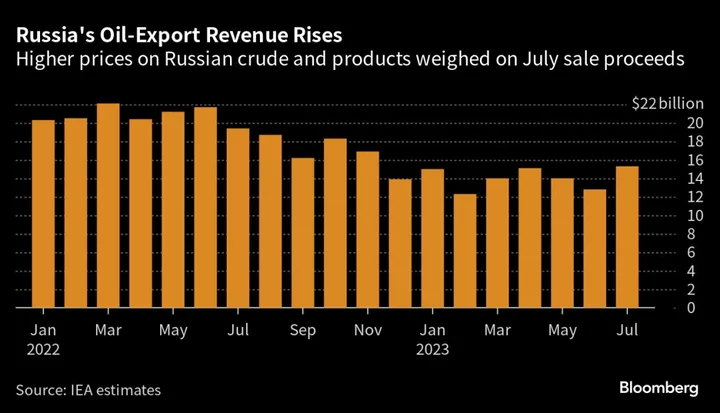Russia’s oil-export revenue rose last month to the highest since November, as the country’s crude exceeded a price cap set by Group of Seven nations, according to the International Energy Agency.
In July, Russia’s crude topped $60 a barrel, breaching the G-7 price cap intended to keep the nation’s supplies in global markets while limiting the inflow of petrodollars to Moscow. The weighted average price for Russian seaborne crude exports rose $8.84 a barrel to $64.41 a barrel, the IEA data shows.
Russia benefited from higher global prices and narrowing discounts on the nation’s crude and petroleum products, the IEA said. The nation earned $15.3 billion from exports of its crude and fuel in July, up by almost 20% from previous month, the IEA said in its monthly market report.
Still, Russia’s oil revenues were down by more than a fifth from a year earlier, according to the IEA. Oil is a key source of revenue for Russian state coffers, which have been strained by the cost of its war in Ukraine and Western sanctions.
The discount of the nation’s main Urals blend to Brent narrowed by some $4 barrels a day, despite North Sea dated prices rising $5 a barrel in July from previous month, according to the IEA. The agency’s estimates are for the so-called free-on-board, or FOB, price which excludes shipping and insurance costs.
“Urals price strength versus the light sweet European marker reflects heightening sour grade supply tensions following OPEC+ supply cuts and a post-maintenance rise in refinery demand,” the IEA said.
Russian crude exports fell amid production curbs and rising supplies to domestic market after major seasonal maintenance was completed.
Read: Russia Raises July Oil Processing as Major Maintenance is Over
Daily crude overseas supplies fell by 200,000 barrels to 4.6 million, the IEA said. Available data show exports eased to China and India, but those countries still accounted for about 80% of Russian shipments, according to the agency.
The decline in crude oil loadings was offset by higher product flows that allowed Russia to keep total oil exports at 7.3 million barrels a day, the same as June, according to the IEA. That matched the lowest in at least a year.
The agency estimated Russia’s crude output at 9.4 million barrels a day in July, down 50,000 barrels from June. That means the nation over-complied with its pledge to cut production by 500,000 barrels day from the February baseline assessed by OPEC secondary sources at 9.949 million barrels a day.
In addition to output curbs, Russia also pledged to reduce its overseas supplies by 500,000 barrels a day this month and taper the cuts to 300,000 barrels a day in September.

